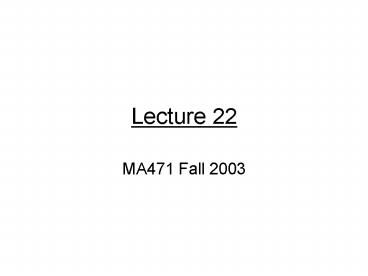MA471 Fall 2003 - PowerPoint PPT Presentation
Title:
MA471 Fall 2003
Description:
JST Advection Equation. We now use the PDE definition. Now Use ... Write an advection code using the JST Runge-Kutta ... Upshot: 2D Advection/DFT. Using ... – PowerPoint PPT presentation
Number of Views:19
Avg rating:3.0/5.0
Title: MA471 Fall 2003
1
Lecture 22
- MA471 Fall 2003
2
Advection Equation
- Recall the 2D advection equation
- We will use a Runge-Kutta time integrator and
spectral representation in space.
3
Periodic Data
- Lets assume we are given N values of a function
f at N data points on the unit interval. - For instance N8 on a unit interval
0 1/8 2/8 3/8 4/8 5/8
6/8 7/8 8/8
4
Discrete Fourier Transform
- We can seek a trigonometric interpolation of a
function f as a linear combination of N (even)
trigonometric functions - Such that
5
Transform
- The interpolation formula defines a linear system
for the unknown fhat coefficients
Or
6
Code for the DFT
7
Code for Inverse DFT
8
Fast Fourier Transform
- See handout
9
Spectral Derivative
- We can differentiate the interpolant by
10
Detail
- We note that the derivative of the k(N/2) mode
- is technically
- However, as we show on the next slide this mode
has turning points at all the data points.
11
Real Component of N/2 Mode
i.e. the slope of the k(N/2) mode is zeroat all
the 8 points..
12
Modified Derivative Formula
- So we can create an alternative symmetric
derivative formula
13
Spectral Differentiation Scheme
- Use an fft to compute
- Differentiate in spectral space. i.e. compute
14
cont
- 3) Then
- 4) Summary
- a) fft transform data to compute coefficients
- b) scale Fourier coefficients
- c) inverse fft (ifft) scaled coefficients
15
Final Twist
- Matlab stores the coefficients from the fast
Fourier transform in a slightly odd order - The derivative matrix will now be a matrix with
diagonal entries
16
Spectral Differentiation Code
Typo See corrected Code on webpage
- DFT data
- Scale Fourier coefficients
- IFT scaled coefficients
17
Two-Dimensional Fourier Transform
- We can now construct a Fourier expansion in two
variables for a function of two variables.. - The 2D inverse discrete transform and discrete
transform are
18
Advection Equation
- Recall the 2D advection equation
- We will use a Runge-Kutta time integrator and
spectral representation in space.
19
Runge-Kutta Time Integrator
- We will now discuss a particularly simple
Runge-Kutta time integrator introduced by
Jameson-Schmidt-Turkel - The idea is each time step is divided into s
substeps, which taken together approximate the
update to sth order.
20
Side note Jameson-Schmidt-Turkel Runge-Kutta
Integrator
- Taylors theorem tells us that
- We will compute an approximate update as
21
JST Runge-Kutta
- The numerical scheme will look like
- We then factorize the polynomial derivative term
22
Factorized Scheme
23
JST Advection Equation
- We now use the PDE definition
24
Now Use Spectral Representation
- A time step now consists of s substages.
- Each stage involves
- Fourier transforming the ctildeusing a fast
Fourier transform (fft) - Scaling the coefficients to differentiate in
Fourier space - Transforming the derivatives back tophysical
values at the nodes by inverse fast Fourier
transform (ifft). - Finally updating ctilde according tothe
advection equation. - At the end we update the concentration.
25
Matlab Implementation
- First set up the nodes and the differentiation
scalings.
26
- 24) Compute dt
- 26) Initiate concentration
- 28-29) compute advection vector
- 32-45) full Runge-Kutta time step
- 35) fft ctilde
- 37) x- and y-differentiation in Fourier space
- 40-41) transform back to physical values of
derivatives - 43) Update ctilde
27
(No Transcript)
28
FFT Resources
- Check out http//www.fftw.org/ for the fastest
Fourier transform in the West - Great list of links
- http//www.fftw.org/links.html
- FFT for irregularly spaced data
- http//www.math.mu-luebeck.de/potts/nfft/
29
Lab Exercise
- Download example DFT code from website.
- Benchmark codes as a function of N
- Write your own version using an efficient FFT
(say fftw) which - FFTs data
- Scales coefficients
- IFFTs scaled coeffients
- Write an advection code using the JST Runge-Kutta
time integrator.
This is the scalar version of Project 4
30
Upshot 2D Advection/DFTUsing MPI_Alltoall
Note using fft the compute time will drop by
approx. A factor of 30 (for N256)
31
Upshot 2D Advection/DFTUsing Non-Blocked Sends
Note I isend and irecv, then compute the
x-derivatives, then waitall, then compute
the y-derivatives, then isend/recv and waitall
(not the best option perhaps).
32
With FFT
- Replacing the DFT calls with FFT calls will
radically reduce the computation time. - It will be much harder to hide the communication
time behind the compute time. - Good luck ?

